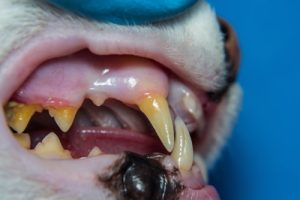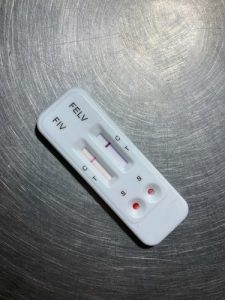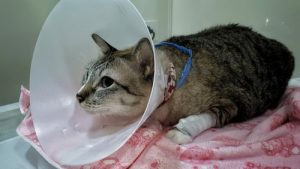Feline leukaemia virus is an incurable disease that affects the immune system of cats. The condition is more common in young cats and is estimated to permanently affect between 1 and 2% of cats in the UK.
Feline leukaemia virus is normally called FeLV. Cats catch the virus through direct contact with infected cats, such as bites or licking. FeLV is sadly a fatal disease, though cats may live up to 4 years or more after diagnosis. Yearly vaccinations help prevent the disease.
Overview
What is feline leukaemia virus in cats?
Feline leukaemia virus belongs to a group of viruses that affect the immune system and can cause cancer in cats.
- FeLV is spread through saliva, urine, faeces and other secretions. It can be spread by licking, grooming, mating and bites. Sharing food or water bowls and litter trays also leads to spread of the infection.
- Close contact is needed for spread. The virus does not survive for long in the environment.
- Pregnant cats that are infected will spread the disease to their kittens. Kittens commonly die before birth.
- Yearly vaccination helps prevent the disease in uninfected cats.
- FeLV is an incurable disease, and sadly, a high percentage of cats will die within 3-4 years after diagnosis.
Infection with FeLV can progress in three different ways:
- If the immune system does not contain the virus, it spreads throughout the body in the blood. This leads to the symptoms of FeLV.
- Another possibility is that the immune system controls the virus in one area of the body and no symptoms develop.
- It is possible for cats to recover from infection if their immune system gets rid of the virus successfully. This is unfortunately not common.
Feline leukaemia virus is a serious and incurable disease. If you suspect your cat is at risk or has any symptoms, speak to a vet as soon as possible. Our Joii Vets are available 24 hours a day for advice.
Symptoms
Symptoms of feline leukaemia virus in cats
The symptoms of feline leukaemia virus can sometimes take months or years to develop.
- Fever and lethargy tend to be the first signs
- Eating less and weight loss
- Diarrhoea, vomiting and other digestive problems
- Sore gums
- Pale gums (due to anaemia)
- Skin disease
- Breeding problems, such as abortion
- Recurrent and persistent infections of different types due to a compromised immune system
- Cancer: most often lymphoma or leukaemia

Symptoms of FeLV are similar to another virus in cats called feline immunodeficiency, and they are often tested for at the same time.
Risk
Are some cats at more risk of feline leukaemia virus than others?
- Young cats and kittens are more at risk of FeLV. Resistance against the infection increases with age.
- Outdoor cats
- Slightly more common in male cats
- Cats living with or in an area with a large population of other cats
- Unvaccinated cats are more at risk of infection
Diagnosis
How is feline leukaemia virus diagnosed in cats?
Diagnosis of feline leukaemia virus can be tricky due to the reliability of the tests:
- An “in-house” blood test is usually quick and inexpensive
- More specialised blood tests are sent to a special lab for confirmation
- Repeat tests after 3 months are often advised to confirm the diagnosis

Other tests may be needed to diagnose secondary infections or cancer:
- Blood tests for the liver, kidneys and other organs
- Urine tests
- Swabs, fluid analysis or biopsies
- Imaging, such as x-rays or ultrasound
Vet treatment
What’s the treatment for feline leukaemia virus in cats?
As feline leukaemia virus is incurable, treatment consists of managing the symptoms.
- Treatment of secondary infections. This may include antibiotics, eye drops, anti-inflammatory medications and pain relief.
- Hospitalisation for monitoring if the symptoms are severe.
- Blood transfusions and other medications if they have anaemia.
- Treatment of cancer may include chemotherapy.

There is no way to predict how long cats will survive after a diagnosis with FeLV.
Some medications may have some effect on the virus but have limited studies in cats
- Interferon, AZT and Raltegravir
Unfortunately, as the disease progresses, your cat will likely become more poorly. If this happens, we recommend discussing euthanasia with your vet to prevent suffering.
Home treatment
How to look after a cat with feline leukaemia virus at home
Cats diagnosed with FeLV are infectious to other cats. They are also more prone to becoming ill due to a weakened immune system.
- Regular vet check-ups (at least twice a year) for a full clinical exam.
- Keep your cat up to date with parasite preventatives and vaccinations.
- Make sure your cat is on a well-balanced nutritional diet. Certain diets may be advised if they are losing weight or have other underlying conditions.
- Monitor their appetite, energy levels and weight regularly to make sure they are not losing weight.
- Access to a steamy room can be useful for cats with respiratory signs.
- Keep your cat indoors to prevent spread to other cats. If your cat is used to being outdoors, follow our guide on stress in cats for tips on how to help them adapt to indoor living. This will also prevent access to other possible diseases that could make your cat ill. Building a secure run in the garden is a good way to keep them active and safe.
- Ideally, keep your cat in a household with no other cats. If there are other cats, keep infected cats completely separated from non-infected cats (even if they are vaccinated).
- Clean any bowls, litter trays or toys with disinfectant before reusing them.
Prevention
Tips on how to prevent feline leukaemia in cats
- The best way to prevent FeLV is to keep your cat indoors or under strict supervision when outdoors.
- Vaccinate your cats against FeLV every year. This is particularly important when they are younger.
- Even if your cat will be indoor only with no other cats, it is advised to vaccinate them against FeLV, especially for the kitten and 1st year vaccinations.
- Test all household cats before introducing new cats or kittens to your house. It is advised to test any new cats too.
- Neuter your cat to reduce fighting with other cats
- Avoid using any bowls, toys or litter trays from infected cats, or make sure to thoroughly disinfect them first. The virus does not survive for long in the environment.
Is my family at risk of catching feline leukaemia virus?
This condition is not zoonotic, which means it does not spread to humans. It does not affect dogs or other animals, except cats.
When to worry
When should you be worried about feline leukaemia virus in cats?
Seek help from a vet if:
- Your cat has difficulty breathing
- Your cat has pale gums or seems weaker than normal
- You want to get your cat tested for feline leukaemia virus
Call us and speak to one of our Joii Vets if:
- You have any questions about the vaccine for feline leukemia virus
- You have any questions about balanced diets for your cat
- Your cat has mild vomiting or diarrhoea
- You have any questions about home treatment for feline leukaemia virus








